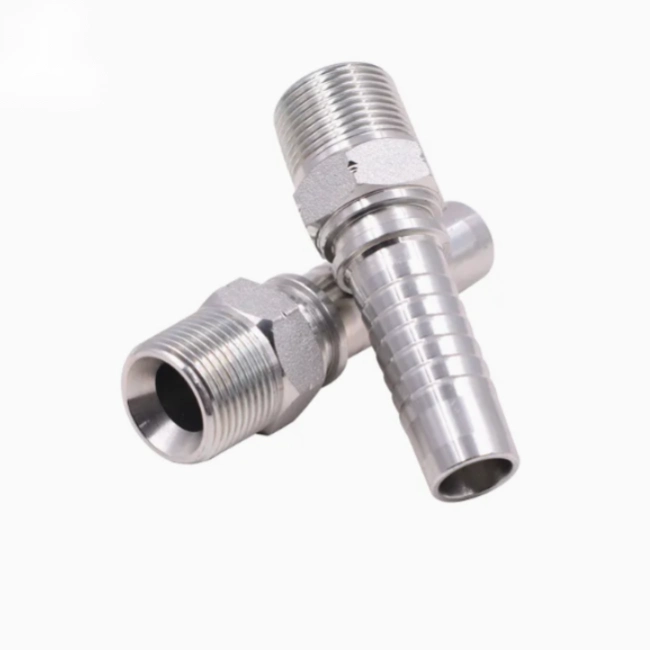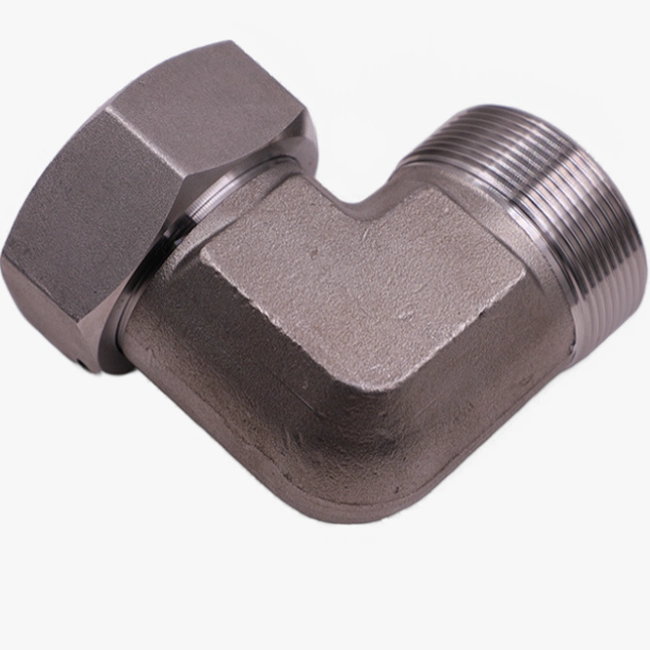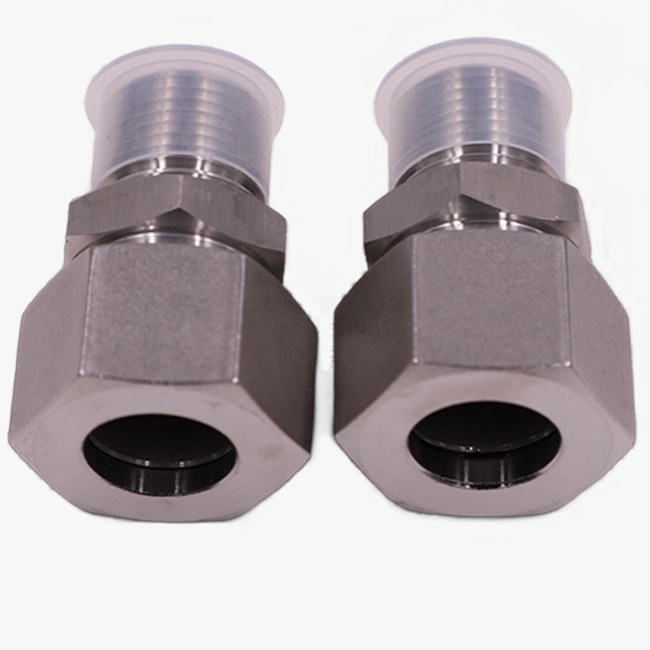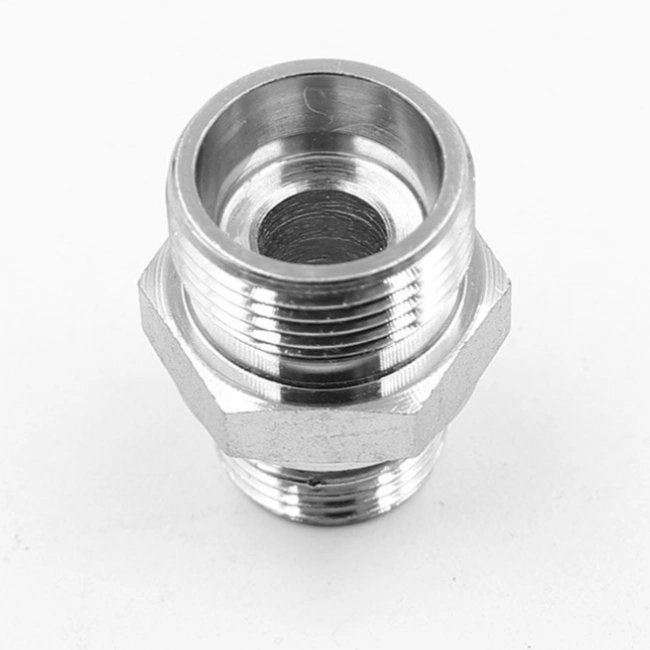NPT Thread Meaning
NPT (National Pipe Thread Taper) is an American standard tapered pipe thread that is widely used for sealing pipe connections in North America.
Its core features are as follows:
Tapered Design: Threads are tapered 1:16 (approximately 0.75mm diameter change per inch of length), sealing is achieved by radial pressure when tightened.
Tooth angle: 60° triangular threads with a flat top and bottom design for enhanced structural strength.
Sealing Mechanism: Relies on thread occlusion in conjunction with sealing materials (e.g., raw tape, sealant), not a pure metal seal.
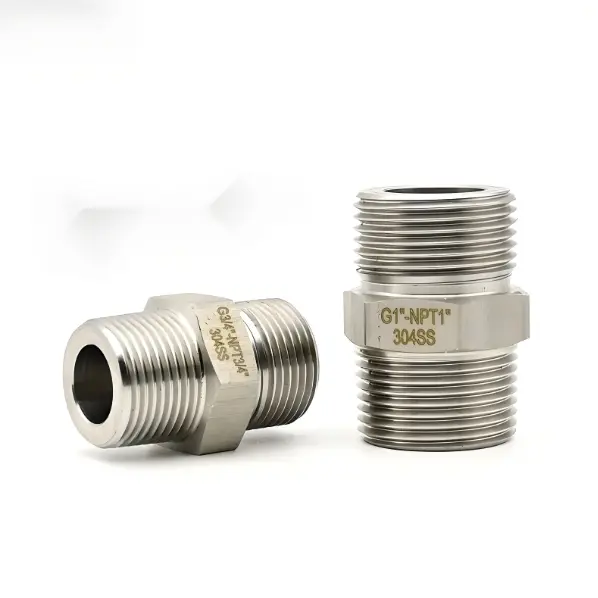
NPT Thread Size
National Pipe Tapered Fuel (NPTF)
| Inch size | Dash size | Threads per Inch | Male Thread O.D. (in) | Female thread O.D (in) | ||
| 1⁄8 | -2 | 27 | 13⁄32 | 0.41 | 3⁄8 | 0.38 |
| 1⁄4 | -4 | 18 | 17⁄32 | 0.54 | 1⁄2 | 0.49 |
| 3⁄8 | -6 | 18 | 11⁄16 | 0.68 | 5⁄8 | 0.63 |
| 1⁄2 | -8 | 14 | 27⁄32 | 0.84 | 25⁄32 | 0.77 |
| 3⁄4 | -12 | 14 | 1 1⁄16 | 1.05 | 1 | 0.98 |
| 1 | -16 | 11 1⁄2 | 1 5⁄16 | 1.32 | 1 1⁄4 | 1.24 |
| 1 1⁄4 | -20 | 11 1⁄2 | 1 21⁄32 | 1.66 | 1 19⁄32 | 1.58 |
| 1 1⁄2 | -24 | 11 1⁄2 | 1 29⁄32 | 1.90 | 1 13⁄16 | 1.82 |
| 2 | -32 | 11 1⁄2 | 2 3⁄8 | 2.38 | 2 5⁄16 | 2.30 |
National Pipe straight mechanical (NPSM)
| Inch size | Dash size | Threads per Inch | Male Thread O.D. (in) | Female thread O.D (in) | ||
| 1⁄8 | -2 | 27 | 13⁄32 | 0.41 | 3⁄8 | 0.38 |
| 1⁄4 | -4 | 18 | 17⁄32 | 0.54 | 1⁄2 | 0.49 |
| 3⁄8 | -6 | 14 | 11⁄16 | 0.68 | 5⁄8 | 0.63 |
| 1⁄2 | -8 | 14 | 27⁄32 | 0.84 | 25⁄32 | 0.77 |
| 3⁄4 | -12 | 14 | 1 1⁄16 | 1.05 | 1 | 0.98 |
| 1 | -16 | 11 1⁄2 | 1 5⁄16 | 1.32 | 1 1⁄4 | 1.24 |
| 1 1⁄4 | -20 | 11 1⁄2 | 1 21⁄32 | 1.66 | 1 19⁄32 | 1.58 |
| 1 1⁄2 | -24 | 11 1⁄2 | 1 29⁄32 | 1.90 | 1 13⁄16 | 1.82 |
| 2 | -32 | 11 1⁄2 | 2 3⁄8 | 2.38 | 2 5⁄16 | 2.30 |
How to distinguish NPT from other threads
Compare with BSPT (British Standard Taper Pipe Thread):
Taper: BSPT is 1:16, same as NPT but with 55° tooth angle.
Compatibility: not directly interchangeable, requires adapter.
Comparison with G thread (parallel thread):
G threads have no taper and rely on O-rings or gaskets for sealing.
Method of identification:
Observe if the end of the thread tapers (tapered characteristic).
Use a thread gauge to measure the tooth angle and taper.
Usage Scenario
Corrosive environment: with stainless steel or brass for chemical piping.
Pneumatic equipment: air compressors, pneumatic tool interfaces.
Limitations: not suitable for frequent disassembly or ultra-high purity systems (sealant residue may remain).
Common types of fittings, couplings or adapters that are compatible with NPT threads
Fittings directly compatible with NPT
NPT Female to Male Fittings
Types: Straight Coupling, Elbow, Tee
Purpose: Connecting pipes or equipment of the same NPT specification, such as hydraulic system piping branch.
Example: 1/2 inch NPT female to 1/2 inch NPT male elbow.
NPT Threaded Plugs/Caps
Purpose: Seal unused NPT ports to prevent contamination or leakage.
Material: brass, stainless steel, plastic (low pressure scenario).
NPT to Hose Fitting
Type: Hose barb fitting (Hose Barb)
Purpose: Connect NPT threaded port to hose (e.g. water hose, pneumatic hose).
Example: 1/4 NPT to 8mm hose barb fitting.
Adapters (NPT compatible with other threads)
NPT to BSPT (British tapered pipe thread)
Scenario: Connecting to UK/European equipment (BSPT is 55° tooth angle, sealant required).
Note: BSPT and NPT tapers are different (1:16 for BSPT, 1:16 for NPT), slightly compatible but not a perfect match, need to test sealing.
NPT to BSPP (inch parallel thread)
Adapter type: Parallel thread fitting with sealing washer.
Purpose: To connect European/Japanese equipment (e.g. pneumatic tools), additional O-ring or gasket sealing required.
NPT to Metric Thread (Metric Thread)
Adapter: M series thread adapter (e.g. M20 x 1.5 to 1/2 NPT).
Application: Connecting metric equipment (e.g. German hydraulic components).
NPT to SAE Flange Fittings
Type: SAE Code 61/62 flange (with O-ring seal).
Application: Hydraulic system for construction machinery, no need for raw bands, direct flange to flange.
NPT to JIS thread (Japanese Industrial Standard)
Scenario: Japanese equipment (e.g. injection molding machine), need to note the difference between JIS taper and NPT.
Special Function Adapters
Quick-change fittings
Type: NPT female to quick-change male.
Usage: Pneumatic/hydraulic lines that are frequently disassembled (e.g. air compressor tools).
Reducing Adapter
Example: 3/4 NPT to 1/2 NPT for transition connection of different pipe diameters.
Universal Swivel
Usage: Scenarios where pipes need to be rotated or angled (e.g. cooling water rotating nozzles).
High pressure adapter
Material: 316 stainless steel, carbon steel with nickel plating.
Pressure level: 3000 PSI or above, used for petroleum, chemical high pressure system.
NPT thread sealing mechanism in detail
- Taper fit: external threads and internal threads extrude radially when tightening, forming a preliminary seal.
- Sealing material filling: raw material tape or glue fills the microscopic gap to stop leakage.
- Pressure assisted: system pressure pushes the threads to bite more tightly, enhancing the sealing.
NPT Thread Precautions
Sealant Selection
NPT threads must be used in conjunction with raw tape (PTFE), thread sealant (e.g. Loctite 545).
Avoid Mixing Criteria
Prohibit direct mixing: NPT and BSPT, G threads, etc. cannot be tightened directly and require special adapters.
Control of the number of tightening turns
NPT taper threads need to be manually screwed in 23 turns and then tightened 12 turns with a tool, over-tightening will easily lead to cracking.
NPT thread installation method and precautions
1.Steps:
Clean the threads: remove oil and debris.
Winding raw material tape: Wind 23 layers clockwise to cover all threads.
Manual pre-tightening: align and hand-tighten until it cannot be turned.
Tool tightening: use a wrench to turn another 1.52 turns (to avoid over-tightening leading to cracking).
- Prohibition:
Do not reverse wrap the raw material tape.
Avoid reusing old threads (prone to leakage).
NPT thread common problems and solutions
- Leakage problem:
Cause: Insufficient sealant, damaged threads, not tightened.
Solution: Re-wrap raw tape after disassembly and check thread integrity. - Thread seizing:
CAUSE: Over tightened or not aligned.
Solution: Use anti-seize agent and slowly reverse rotation to exit. - Sealant contamination of system:
Solution: Change to low residual sealant or NPTF dry seal threads.
Summarize
NPT threads have become the standard choice in North American industry due to their reliable tapered seal design. Proper installation and maintenance are key, and it performs well in high-pressure, corrosive environments, but compatibility and use-scenario limitations should be noted. For frequent disassembly or high cleanliness requirements, flange or clamp connection alternatives are recommended. If you have any other questions about NPT thread related products, you can contact our engineers and we will answer them for you free of charge.
If you want to know more about NPT, please check below:
Understanding the difference between NPT vs NPTF threaded connections

